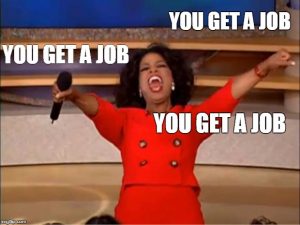
By Brandi Leos, City of Tigard; find me on Twitter and LinkedIn
What I’m Reading: Running is my Therapy by Scott Douglas
What I’m Watching: Workout videos on the Peloton Digital App (this thing is awesome and I didn’t have to buy a bike)
What I’m Listening To: The NPR Politics Podcast – bite size politics news in 15-30 minutes/day
Succession planning… this term makes HR people cringe. Nothing sounds more like “here’s a job we’re planning to give you.” As someone who wants more than anything to ensure fair hiring processes and to bring new perspectives into government, guaranteeing (or the appearance of guaranteeing) a job to anyone makes me want to run from City Hall screaming.
 Um… no.
Um… no.
I was listening to our Police Chief a couple weeks ago as she announced changes among the command staff assignments. As their HR Partner, I am accustomed to the changing of responsibilities among the management ranks every couple of years. The Commander in charge of patrol moves to detectives and internal services and the Commander in charge of internal services and detectives moves to patrol.
There is also a shift of responsibilities among the Lieutenants. It’s always a bit of a shuffle but it smooths out rather quickly. The Chief said in her meeting, we change not just for the sake of change… this is our succession plan. And she’s right. She’s developing her bench – making sure the leaders in the department are ready to take on any role thrown at them and to do it well.
The Chief’s comments got me thinking in a different way about some practices I would like to put in place and have put a bit of thought into… How do we build our bench and make sure we have people ready to step into new roles (without guaranteeing a job)? I’ve been thinking about this for a long time and I have a few ideas to share.
Embark on unique opportunities to develop staff. If a manager retires or takes another opportunity, don’t dwell too long. This is an excellent chance to build your bench. When a manager vacancy is open, take some time (six months to two years). Open the vacancy as an internal, temporary development opportunity. You’ll give someone the chance to learn new skills, give them some resume padding, and try them out for a while (heck, allow a few people the chance to serve this way). Back-fill the job they left with an opportunity for someone else. Back-fill until you get to the lowest level of responsibility and fill with a temporary employee or a regular employee with an agreed-upon limited duration of employment. Everyone knows their end-date and that they’ll return to their regular role at the end. Will you lose some employees? Probably… they may get supervisory or management jobs elsewhere, but you will have built up staff to take on the role, creating more engagement and loyalty. I have had success doing this for shorter periods of time, too – providing the opportunity for multiple employees and then conducting a competitive interview process to select the best candidate. This is a great way to ensure your internal candidates shine.
Give back to your profession. If you have an entry-level job in a sought-after profession, consider opening the job for limited employment (2-3 years). Take the time to train employees in a few different aspects of the profession and release them into the world for other local govs to seize upon. This is a great solution for an organization without a ton of opportunity to move up. Instead, you’re training employees to move on and contributing to your profession. Who knows, maybe they’ll come back to you someday after going out and getting the next level of development somewhere else. I know this sounds like a lot of turnover, but it’s intentional and helps keep fresh ideas and perspectives coming your way. Do not be afraid of turnover.
Rotate. I hear a lot lately about innovation teams. How innovative would it be to staff your innovation team with rotational assignments? Much like the developmental opportunities discussed above, the rotational assignment would be of limited term, allowing someone to work in innovation without giving up their job (again, back-filled with limited term assignments). As a management analyst turned HR Partner, I would LOVE to spend 1-2 years on an innovation team and then return to my job with my newfound knowledge and excitement about what’s going on in the rest of the organization. I think a small innovation team could be fully staffed with limited term rotational assignments in which employees get specialized training and access to the organization as a whole. Imagine a future department director who has worked on organization-wide innovation and the new perspective they could infuse into your leadership team.
Cross-training. More than going to class – take the opportunity to cross-train employees. This is exactly what our Chief is doing and could be implemented in any department. When employees have more than one skill-set, you can select not just the best technician to be a leader, but the best leader to guide the best technicians. This is why your recruiter should know the HRIS. Your water distribution people show know a thing or two about street repair. Your Detective Sergeant should be able to handle patrol. Any department head should be ready to step in as Assistant City Manager.
When “succession planning,” make sure you have people ready to step in where the organization needs them. It might not be their dream job, but they can do it, which is sometimes all you need. Succession planning is not always about finding the perfect fit but ensuring the continued operation of the essential business needs of the organization. You might just end up with employees who are confident enough to compete for the job they want, because no one wants a boss they could have beat out of the job.
I would love to hear about innovative approaches to succession planning happening in your workplace. Please feel free to connect and start a conversation.
